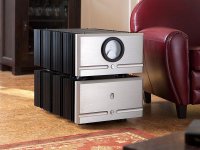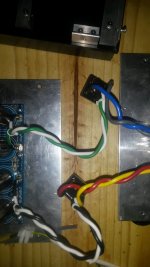Thanks for the speedy responses. I am going to be using the DIY Audio PSU PCB V3 that is currently for sale at the site's shop. I'm not sure which one of "trCCCCC PSU, or rCRCCC, or rCCRCC" it is though. Thanks again, Tiz.
Can someone else jump in and help?
I can't help a Member that knows nothing.
Start with learning how a PSU works.
I can't help a Member that knows nothing.
Start with learning how a PSU works.
I have a beginners idea of how a psu works. I know that I can put what I have on the board and it will work with the four capacitors I ordered. I also know that I can follow the build guide and complete the psu successfully. I was under the impression that this thread is about the DIY Audio PSU V3. As a beginner, I assumed that my question would be answered by someone who knows more than I do and that I would learn from this process. What I'm asking for is advice on the capacitor options that I have handy and which, if any, would be the best sounding choice. Is this thread here for experts to communicate with experts only? If so, that's not very DIY friendly.
Tizman, in the Aleph J build thread, Qty 4 33,000uF caps are used. I wouldn't bother buying 4 more if you don't need it. Pay attention to the traces on the PSU V3 board. One cap needs to go in each of the 4 quadrants. For simplicity's sake, you could put all the caps in the middle 4 positions, or the outer 4 positions.
The older PSU board in the Aleph J build thread has "inbetween" positions on the screenprint if the user wants to run 4 caps instead of 8. This newer PSU board doesn't have that accoutrement on the screenprint. Just pick the spots you want to use.
Altermatively, just buy the 4 extras and have more juice.
The older PSU board in the Aleph J build thread has "inbetween" positions on the screenprint if the user wants to run 4 caps instead of 8. This newer PSU board doesn't have that accoutrement on the screenprint. Just pick the spots you want to use.
Altermatively, just buy the 4 extras and have more juice.
Last edited:
Hi tizman
I would use the four 33000uf capacitors as a CRC (per supply rail) then add the two 62000uf Mallory to the output(s) (CRCC) and two of the 75uf Shizuki (CRCCc), I'm not sure how much differance adding the smaller electrolytics (6800uf Elna) to the input(s) would make (CCRCCc), it would be a matter of 'suck it and see' (but as papa said, you can never have too much).
Save the rest of the caps for another project.
I would use the four 33000uf capacitors as a CRC (per supply rail) then add the two 62000uf Mallory to the output(s) (CRCC) and two of the 75uf Shizuki (CRCCc), I'm not sure how much differance adding the smaller electrolytics (6800uf Elna) to the input(s) would make (CCRCCc), it would be a matter of 'suck it and see' (but as papa said, you can never have too much).
Save the rest of the caps for another project.
Thanks Itsmee.
Just to confirm, the Mallorys would be off the
PSU board, and between the PSU output and the Aleph J board power inputs? Would I then put the Shizuki film caps after the Mallorys, or does the small c mean that they would be used to bypass the Mallorys?
Just to confirm, the Mallorys would be off the
PSU board, and between the PSU output and the Aleph J board power inputs? Would I then put the Shizuki film caps after the Mallorys, or does the small c mean that they would be used to bypass the Mallorys?
Thanks for the lesson Itsmee. Will do. If I can figure out how to fit them all in the chassis. Is it ever advisable to set up capacitors outside of the chassis? I'm thinking I could create an outlet that either connects to an external capacitor bank, or that can be jumpered to use only the internal caps. This would require an additional two feet or so of wiring to get back and forth. Is this a crazy idea?
Hi tizman,
It's not advisable to have long leads from the capacitors to the amplifier boards, it can lead to instibility, if you can't fit them in the chassis, don't use them.
Just fit the Shizuki caps to the PSU board.
Papa does make amplifiers with the power supply in a seperate chassis, but they also have some local decoupling in the amplifier chassis.
It's not advisable to have long leads from the capacitors to the amplifier boards, it can lead to instibility, if you can't fit them in the chassis, don't use them.
Just fit the Shizuki caps to the PSU board.
Papa does make amplifiers with the power supply in a seperate chassis, but they also have some local decoupling in the amplifier chassis.
Attachments
Is it better to have no snubber components on the power supply board rather than choosing arbitrary values?
If installing anything is better than installing nothing, I would install something.
If it's detrimental, I'll skip it. Dozens of power supplies without a snubber, what's one more. 😉
Using Antek 18+18 400VA shielded.
Not building a Quasimodo.
Thanks for your input or output.
Happy Holidays and Merry Christmas!
Vince
If installing anything is better than installing nothing, I would install something.
If it's detrimental, I'll skip it. Dozens of power supplies without a snubber, what's one more. 😉
Using Antek 18+18 400VA shielded.
Not building a Quasimodo.
Thanks for your input or output.
Happy Holidays and Merry Christmas!
Vince
I've always built mine empty. That said,
Would you like to borrow my Quasimodo?
Thanks but I'll leave it blank.
hum
hi guys,
I have a question about the PSU ive built, I used the V3 board of the diyaudio store and i'm using it for a Aleph J built. The reason why I post this question is because when I finished the build i stumbled into a hum problem I would like to get rid off. So far the background intel 🙂.
I dissasembled the casing ive build and laid out the whole on a table, next i connected the transformer to the psu and the psu to the Aleph J boards and the speakers to the speak output (nothing connected on RCA) and fired up and all lights got up. Ive noticed severall things:
1- light hum on right speaker (ignore this for the moment because this isnt the right place for debugging this).
2- the transformer buzzes, noticable when my ear is 20 cm off.
3- a buz from the psu board.
i tried a couple of things:
1- dissasembled the on/off button. no changes after this action.
2- dissasembled the NTC thermisters, i use these for a slow start. no changes after this action.
3- waited for a 15 minutes to warm everything up, maybe just a buzz when all the caps are empty. but even after 15 minutes the buz of the transformer and psu are still there.
4- disconnected the Aleph J boards, no buzz form the psu board but transformer stil lightly buzzes.
Am i going insane here? is this normal or are these buzzes mentioned above coming from DC on the mains??
I used the standard bom material except for the transformer, its a 500va Amplimo. caps are nichicon 15.000uf.
I've made some photo's i will try and upload these in a bit.
hi guys,
I have a question about the PSU ive built, I used the V3 board of the diyaudio store and i'm using it for a Aleph J built. The reason why I post this question is because when I finished the build i stumbled into a hum problem I would like to get rid off. So far the background intel 🙂.
I dissasembled the casing ive build and laid out the whole on a table, next i connected the transformer to the psu and the psu to the Aleph J boards and the speakers to the speak output (nothing connected on RCA) and fired up and all lights got up. Ive noticed severall things:
1- light hum on right speaker (ignore this for the moment because this isnt the right place for debugging this).
2- the transformer buzzes, noticable when my ear is 20 cm off.
3- a buz from the psu board.
i tried a couple of things:
1- dissasembled the on/off button. no changes after this action.
2- dissasembled the NTC thermisters, i use these for a slow start. no changes after this action.
3- waited for a 15 minutes to warm everything up, maybe just a buzz when all the caps are empty. but even after 15 minutes the buz of the transformer and psu are still there.
4- disconnected the Aleph J boards, no buzz form the psu board but transformer stil lightly buzzes.
Am i going insane here? is this normal or are these buzzes mentioned above coming from DC on the mains??
I used the standard bom material except for the transformer, its a 500va Amplimo. caps are nichicon 15.000uf.
I've made some photo's i will try and upload these in a bit.
Attachments
Last edited:
The wires in a transformer windings pass pulses of current.
When wires pass current in the presence of a magnetic field there is a force on the wire.
Pulses of current will give pulses of force.
Opposite polarity pulses will give opposite polarity forces.
result: the wire moves.
If it's surrounded in a stiff medium it won't move much. If it's able to move in free air it will move a lot.
Movement is vibration and that is audbile if the movement coincides with the 50/60Hz, or it's harmonics.
When wires pass current in the presence of a magnetic field there is a force on the wire.
Pulses of current will give pulses of force.
Opposite polarity pulses will give opposite polarity forces.
result: the wire moves.
If it's surrounded in a stiff medium it won't move much. If it's able to move in free air it will move a lot.
Movement is vibration and that is audbile if the movement coincides with the 50/60Hz, or it's harmonics.
The output from the PSU is a three wire dual polarity supply.
You take that to your amplifier.
You wire up the amplifier to your rules.
You take that to your amplifier.
You wire up the amplifier to your rules.
The wires in a transformer windings pass pulses of current.
When wires pass current in the presence of a magnetic field there is a force on the wire.
Pulses of current will give pulses of force.
Opposite polarity pulses will give opposite polarity forces.
result: the wire moves.
If it's surrounded in a stiff medium it won't move much. If it's able to move in free air it will move a lot.
Movement is vibration and that is audbile if the movement coincides with the 50/60Hz, or it's harmonics.
dear andrew,
thanks for your explanation, I will bolt the transformer to the bottom plate and check again, so if I understand you correctly, a transformer will hum Always a bit because of the polarity forces?
but what about the hum from the capacitors, do i have to worrie about that?
- Home
- The diyAudio Store
- V3 Universal Power Supply Circuit Board



